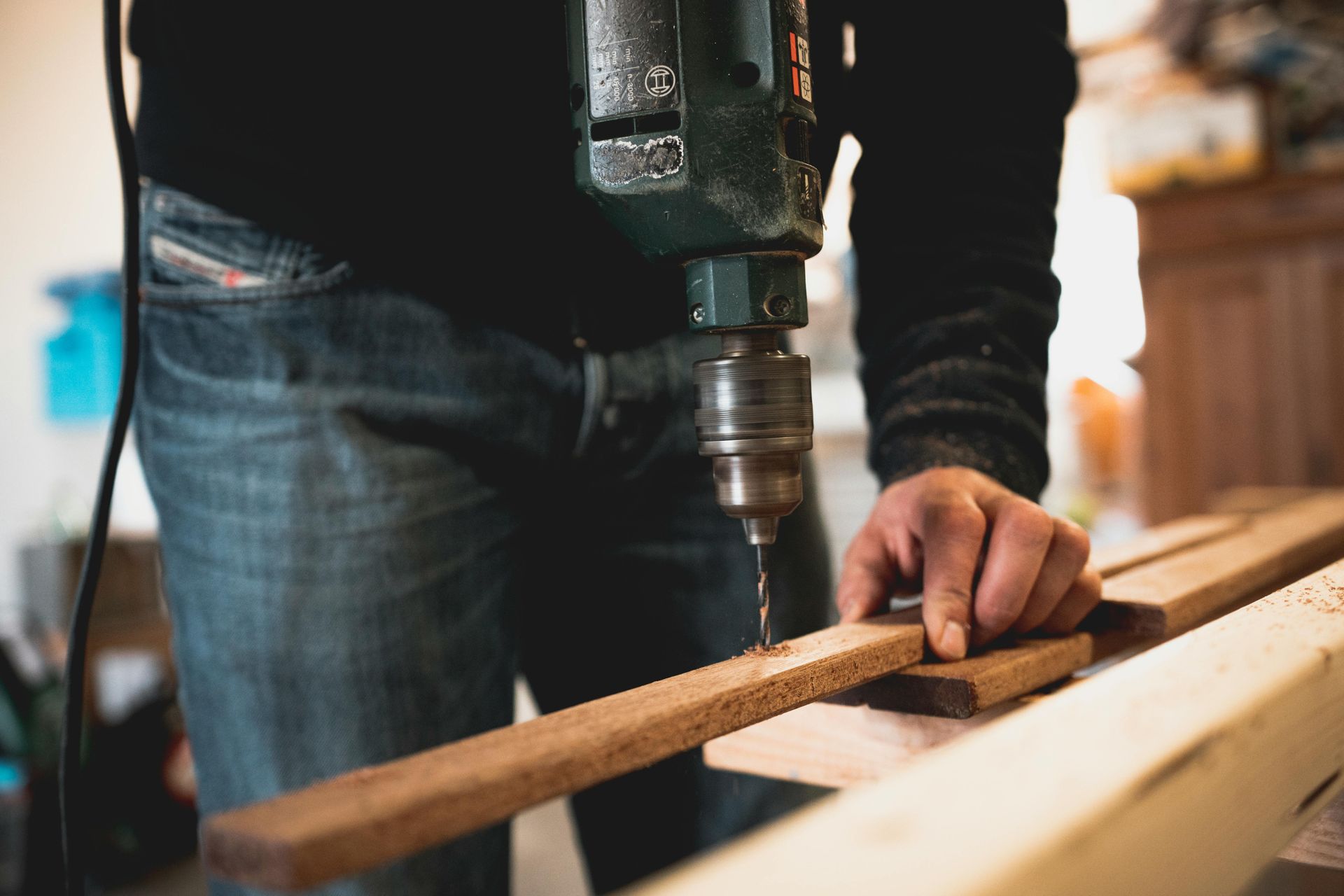A Beginner’s Guide to Understanding Wood Types for Home Projects
January 8, 2025

A Beginner’s Guide to Understanding Wood Types for Home Projects
Wood has been a staple material in home projects for centuries. Its versatility, warmth, and durability make it a favorite for everything from furniture to flooring. But not all wood is the same, and picking the right type can make or break your project. If you’re new to working with wood, this guide will help you understand the basics so you can choose the perfect material for your needs.
Hardwood vs. Softwood: What’s the Difference?
Wood falls into two main categories: hardwood and softwood. These terms aren’t about the actual hardness of the wood but rather the type of tree it comes from.
Hardwood
Hardwoods come from deciduous trees, which shed their leaves in the fall. Common hardwoods include oak, maple, walnut, and cherry. They’re typically denser and more durable, making them ideal for furniture and high-traffic areas.
Characteristics:
Dense and strong
Often more expensive
Available in a variety of colors and grain patterns
Softwood
Softwoods are sourced from coniferous trees, which stay green year-round. Examples include pine, cedar, and spruce. Softwoods are generally lighter and easier to work with, making them a popular choice for DIYers.
Characteristics:
Lightweight and easy to cut
More affordable than hardwoods
Often have a straight grain
Great for framing, paneling, and decorative projects
Popular Wood Types and Their Uses
Let’s take a closer look at some common wood types and what they’re best suited for:
Oak
Oak is a classic hardwood known for its strength and timeless appeal. It’s available in red and white varieties, with white oak being more resistant to moisture.
Uses:
Flooring
Furniture
Cabinetry
Pine
Pine is a versatile, budget-friendly softwood. Its light color and visible knots give it a rustic charm, and it takes paint and stain well.
Uses:
Furniture
Shelving
Maple
Maple is a dense hardwood with a smooth, fine grain. Its durability makes it a popular choice for high-use areas, and it can be stained to mimic pricier woods like cherry.
Uses:
Kitchen countertops
Furniture
Cedar
Cedar is prized for its natural resistance to insects and rot. Its distinct aroma and reddish hue make it a favorite for outdoor and decorative projects.
Uses:
Outdoor furniture
Decking
Walnut
Walnut is a dark, rich hardwood with unique grain patterns. It’s often used in high-end furniture and decorative pieces.
Uses:
Tables
Cabinets
Decorative accents
Cherry
Cherry wood has a warm reddish-brown color that deepens over time. Its smooth grain and polished look make it a go-to for elegant interiors.
Uses:
Fine furniture
Cabinets
Engineered Wood: A Practical Alternative
Solid wood isn’t your only option. Engineered wood products like plywood, MDF, and particleboard are affordable and versatile alternatives. Each has its own strengths and ideal applications.
Plywood
Made by gluing together thin layers of wood veneer, plywood is strong and stable. It’s available in various grades and thicknesses to suit different needs.
Uses:
Cabinets
Subflooring
MDF
Medium-density fiberboard (MDF) is crafted from compressed wood fibers. It has a smooth surface perfect for painting but isn’t as strong as plywood.
Uses:
Furniture
Trim
Decorative panels
Particleboard
Particleboard is made from wood chips and resin. It’s lightweight and budget-friendly but less durable than other options.
Uses:
Budget cabinetry
Flat-pack furniture
Shelving
How to Choose the Right Wood for Your Project
When selecting wood, keep these factors in mind:
Durability: Hardwoods like oak and maple are great for high-traffic areas, while cedar’s resistance to rot makes it ideal for outdoor use.
Appearance: Grain patterns, color, and texture play a big role in the final look of your project. Choose a wood that complements your design.
Workability: If you’re new to carpentry, start with softer woods like pine, which are easier to cut and shape.
Cost: Hardwoods tend to be more expensive. For budget-friendly options, consider softwoods or engineered wood.
Environment: For outdoor projects, select woods resistant to moisture and insects, such as cedar or pressure-treated lumber.
Sustainable Choices
If sustainability is important to you, look for reclaimed wood or materials certified by the Forest Stewardship Council (FSC). These options help reduce environmental impact and support responsible forestry practices.
Tips for Working with Wood
Let It Acclimate: Allow wood to sit in your home environment for a few days before using it. This helps prevent warping or shrinking later.
Use the Right Tools: Invest in quality tools for cutting, sanding, and finishing to get professional results.
Test Your Finishes: Always try out stains or paints on a scrap piece before applying them to your project.
Final Thoughts
Understanding wood types is key to successful home projects. Whether you’re crafting a custom bookshelf, installing new trim, or renovating a kitchen, choosing the right wood can make all the difference. With this guide, you’ll have the knowledge to pick materials that match your style, budget, and needs—and create something you’ll be proud of for years to come.
Wood has been a staple material in home projects for centuries. Its versatility, warmth, and durability make it a favorite for everything from furniture to flooring. But not all wood is the same, and picking the right type can make or break your project. If you’re new to working with wood, this guide will help you understand the basics so you can choose the perfect material for your needs.
Hardwood vs. Softwood: What’s the Difference?
Wood falls into two main categories: hardwood and softwood. These terms aren’t about the actual hardness of the wood but rather the type of tree it comes from.
Hardwood
Hardwoods come from deciduous trees, which shed their leaves in the fall. Common hardwoods include oak, maple, walnut, and cherry. They’re typically denser and more durable, making them ideal for furniture and high-traffic areas.
Characteristics:
Dense and strong
Often more expensive
Available in a variety of colors and grain patterns
Perfect for furniture, flooring, and cabinetry
Softwood
Softwoods are sourced from coniferous trees, which stay green year-round. Examples include pine, cedar, and spruce. Softwoods are generally lighter and easier to work with, making them a popular choice for DIYers.
Characteristics:
Lightweight and easy to cut
More affordable than hardwoods
Often have a straight grain
Great for framing, paneling, and decorative projects
Popular Wood Types and Their Uses
Let’s take a closer look at some common wood types and what they’re best suited for:
Oak
Oak is a classic hardwood known for its strength and timeless appeal. It’s available in red and white varieties, with white oak being more resistant to moisture.
Uses:
Flooring
Furniture
Cabinetry
Pine
Pine is a versatile, budget-friendly softwood. Its light color and visible knots give it a rustic charm, and it takes paint and stain well.
Uses:
Furniture
Shelving
Trim and moulding
Maple
Maple is a dense hardwood with a smooth, fine grain. Its durability makes it a popular choice for high-use areas, and it can be stained to mimic pricier woods like cherry.
Uses:
Kitchen countertops
Furniture
Cutting boards
Cedar
Cedar is prized for its natural resistance to insects and rot. Its distinct aroma and reddish hue make it a favorite for outdoor and decorative projects.
Uses:
Outdoor furniture
Decking
Closet linings
Walnut
Walnut is a dark, rich hardwood with unique grain patterns. It’s often used in high-end furniture and decorative pieces.
Uses:
Tables
Cabinets
Decorative accents
Cherry
Cherry wood has a warm reddish-brown color that deepens over time. Its smooth grain and polished look make it a go-to for elegant interiors.
Uses:
Fine furniture
Cabinets
Interior trim
Engineered Wood: A Practical Alternative
Solid wood isn’t your only option. Engineered wood products like plywood, MDF, and particleboard are affordable and versatile alternatives. Each has its own strengths and ideal applications.
Plywood
Made by gluing together thin layers of wood veneer, plywood is strong and stable. It’s available in various grades and thicknesses to suit different needs.
Uses:
Cabinets
Subflooring
Shelving
MDF
Medium-density fiberboard (MDF) is crafted from compressed wood fibers. It has a smooth surface perfect for painting but isn’t as strong as plywood.
Uses:
Furniture
Trim
Decorative panels
Particleboard
Particleboard is made from wood chips and resin. It’s lightweight and budget-friendly but less durable than other options.
Uses:
Budget cabinetry
Flat-pack furniture
Shelving
How to Choose the Right Wood for Your Project
When selecting wood, keep these factors in mind:
Durability: Hardwoods like oak and maple are great for high-traffic areas, while cedar’s resistance to rot makes it ideal for outdoor use.
Appearance: Grain patterns, color, and texture play a big role in the final look of your project. Choose a wood that complements your design.
Workability: If you’re new to carpentry, start with softer woods like pine, which are easier to cut and shape.
Cost: Hardwoods tend to be more expensive. For budget-friendly options, consider softwoods or engineered wood.
Environment: For outdoor projects, select woods resistant to moisture and insects, such as cedar or pressure-treated lumber.
Sustainable Choices
If sustainability is important to you, look for reclaimed wood or materials certified by the Forest Stewardship Council (FSC). These options help reduce environmental impact and support responsible forestry practices.
Tips for Working with Wood
Let It Acclimate: Allow wood to sit in your home environment for a few days before using it. This helps prevent warping or shrinking later.
Use the Right Tools: Invest in quality tools for cutting, sanding, and finishing to get professional results.
Test Your Finishes: Always try out stains or paints on a scrap piece before applying them to your project.
Final Thoughts
Understanding wood types is key to successful home projects. Whether you’re crafting a custom bookshelf, installing new trim, or renovating a kitchen, choosing the right wood can make all the difference. With this guide, you’ll have the knowledge to pick materials that match your style, budget, and needs—and create something you’ll be proud of for years to come.

